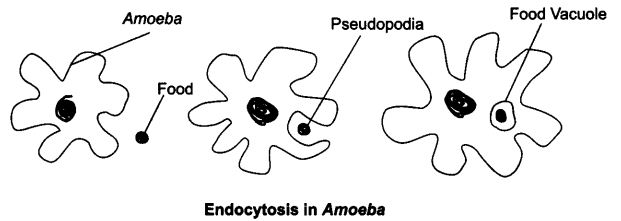Search This Blog
Hllo students hope u do'in good , welcome and search your query here
Featured Post
- Get link
- X
- Other Apps
the fundamental unit of cell class 9 solutions NCERT CBSE
the fundamental unit of cell class 9 solutions NCERT CBSE
1. Make a comparison and write down ways in which plant cells are also different from animal cells.
Answer:
Question 2. How is a prokaryotic cell different from a eukaryotic cell?
Answer: Prokaryotic cell is generally smaller in size (1-10 pm), the nuclear region is poorly defined, the cell organelles are not membrane-bound and have a single chromosome.
A eukaryotic cell is generally larger in size (5-100 pm), the nuclear region is well defined with the nuclear membrane. Membrane-bound cell organelles are present and have more than one chromosome.
Question 3. What would happen if the plasma membrane ruptures or breaks down?
Answer: If the plasma membrane ruptures or breaks down then molecules of some substances will freely move in and out.
Question 4. What would happen to the life of a cell if there was no Golgi apparatus?
Answer: Golgi apparatus has the function of storage, modification, and packaging of the products in vesicles. If there were no Golgi bodies, packaging and dispatching of materials synthesized by the cell will be stocked.
Question 5. Which organelle is known as the powerhouse of the cell? Why?
Answer: Mitochondria is known as the powerhouse of the cell because it releases the energy required for different activities of life.
Question 6. Where do the lipids and proteins constituting the cell membrane get synthesized?
Answer: Lipids and proteins are synthesized in ER [Endoplasmic Reticulum].
Question 7. How does Amoeba obtain its food?
Answer: Amoeba takes their food by the cell membrane which forms the food vacuole.
Question 8. What is osmosis?
Answer: Osmosis is the process of movement of water molecules from a region of higher water concentration through a semi-permeable membrane to a region of lower water concentration.
Question 9. Carry out the following osmosis experiment:
Take four peeled potato halves and scoop each one out to make potato cups, one of these potato cups should be made from a boiled potato. Put each potato cup in a trough containing water.
Now,
(a) Keep cup A empty
(b) Put one teaspoon sugar in cup B
(c) Put one teaspoon salt in cup C ‘
(d) Put one teaspoon sugar in the boiled potato cup D
Keep these for two hours. Then observe the four potato cups and answer the following:
(i) Explain why water gathers in the hollowed portion of B and C.
(ii) Why is potato A necessary for this experiment?
(iii) Explain why water does not gather in the hollowed-out portions of A and D.
Answer:
(i) Water gathers in B and C because in both situations there is a difference in the concentration of water in the trough and water in the cup of Potato. Hence, osmosis takes place as the potato cells act as a semi-permeable membrane.
(ii) Potato A is necessary for this experiment for comparison, it acts as a control.
(iii) Water does not gather in the hollowed-out portions of A and D. As a cup of A does not have a change in the concentration for water to flow. For osmosis to occur one of the concentrations should be higher than the other.
In cup D, the cells are dead, and hence the semi-permeable membrane does not exist for the flow of water and no osmosis takes place.
Popular Posts
Allen test series 2020 free pdf download for neet
- Get link
- X
- Other Apps
the living world exemplar solutions NEET NCERT
- Get link
- X
- Other Apps
Allen Test Series For Neet 2017 Pdf Free Download
- Get link
- X
- Other Apps
living world class 11th NCERT solutions CBSE
- Get link
- X
- Other Apps
DC PANDEY for neet preparation pdf full book pdf
- Get link
- X
- Other Apps
strategies for enhancement in food production solutions NCERT CBSE class 12
- Get link
- X
- Other Apps
Allen Test Series For Neet 2019 Pdf Free Download
- Get link
- X
- Other Apps
Allen Test Series For Neet 2018 Pdf Free Download
- Get link
- X
- Other Apps
reproduction in organisms class 12 CBSE NCERT to the point
- Get link
- X
- Other Apps

Comments
Post a Comment
Hello ✋ welcome ,I hope u get something today